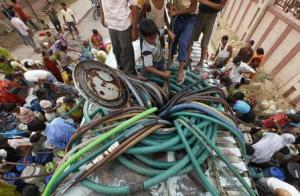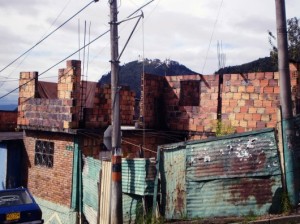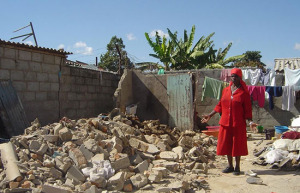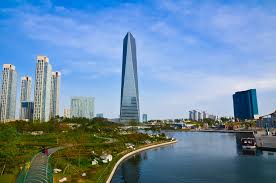Steph – Urban Subversion ~ 13 Radical Examples Of Guerrilla Housing
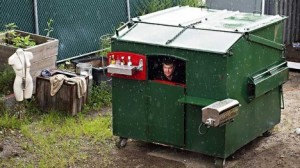 weburbanist.com. October 2014. Vacant lots, billboards, rooftops and even dumpsters are hacked into inhabitable spaces in these examples of often-illegal guerrilla housing. All manner of urban surfaces can be subverted into safe, dry shelters, often taking examples in gray areas of local laws or flying under the radar simply because they blend so well into the city environment.
weburbanist.com. October 2014. Vacant lots, billboards, rooftops and even dumpsters are hacked into inhabitable spaces in these examples of often-illegal guerrilla housing. All manner of urban surfaces can be subverted into safe, dry shelters, often taking examples in gray areas of local laws or flying under the radar simply because they blend so well into the city environment.
Read & see more: http://weburbanist.com/guerrilla-housing
OneWorld South Asia ~ Water ATMs: Improving Water Accessibility In Delhi Slums
September 2014. New Delhi: Water ATMs may improve accessibility, affordability and quality of drinking water in slum areas. Experts studied the functioning of Water ATMs and Treatment Plant in Savdha Ghevra resettlement colony of North-West Delhi as part of the yatra on Innovations in Urban Water Services organised by global think tank – Development Alternatives Oct 14, 2014, New Delhi.
In the absence of piped water supply, several far flung areas in Delhi continue to remain inaccessible to safe drinking water supply. The problem is more serious when it comes to unauthorised localities, slum areas and resettlement colonies in the city, where drinking water remains a scarce resource.
The current civic infrastructure doesn’t have the capacity to provide for the growing demand of water in the city and what the situation urgently needs is innovations in water supply and usage. These and related issues were discussed today by experts in a yatra organised by Development Alternatives (DA) in Savdha Ghevra resettlement colony in North-West Delhi.
The objective of the yatra was to study innovations in urban water services, and how these small interventions could result in substantial improvements to system efficiency across varying water collection, purification and distribution mechanisms.
The yatra was attended by representatives from Central Pollution Control Board, Central Ground Water Board, Delhi Jal Board, World Bank, INTACH as well as NGOs including Center for Science & Environment, Darvajal and Gramvikas. Savdha Ghevra is a 250 acres resettlement colony near Ghevra railway station on Delhi-Rohtak rail route in North West Delhi.
It is divided into several blocks, where approximately 30 000 people live. The inhabitants have fairly regular access to electricity but not to water. Furthermore, much of the promised infrastructure has not been developed, resulting in inadequate civic amenities.
Read more: http://southasia.oneworld.net/water
Laura Amaya – From Bogotá To Bombay: How The World’s ‘Village-Cities’ Facilitate Change
stealmag.com. October 2014. Perched behind the fog that conceals Bogotá’s mountains is William Oquendo’s house. It is a labyrinth of doors and windows, wherein a bedroom opens into the kitchen and a bathroom vents out into the living room.
Five thousand 5,000 kilometers away in Rio de Janeiro, Gilson Fumaça lives on the terrace level of a three-story house built by his grandfather, his father, and now himself. It’s sturdy; made out of brick and mortar on the ground floor, concrete on the second, and a haphazard combination of zinc roof tiles and loose bricks on the third. The last is Gilson’s contribution, which he will improve as his income level rises.
On the other side of the world in Bombay (Mumbai since 1995), houses encroach on the railway tracks, built and rebuilt after innumerable demolition efforts. “The physical landscape of the city is in perpetual motion,” Suketu Mehta observes in ‘Maximum City.’ Shacks are built out of bamboo sticks and plastic bags; families live on sidewalks and under flyovers in precarious homes constructed with their hands. And while Dharavi—reportedly the largest slum in Asia—has better quality housing, running water, electricity and secure land tenure, this is not the case for most of the new migrants into the city.
Read more: http://stealmag.com/architecture/
Garikai Chaunza – Zimbabwe’s High Court Stays House Demolitions, Thousands Already Homeless
fsrn.org. October 2014. In Zimbabwe, a court has ordered the government to halt a program of evictions and demolitions that has already rendered about three thousand families homeless. As the rainy season approaches, it’s unclear if officials will appeal the decision. Garikai Chaunza reports.
The high court has ordered the government to stop demolishing homes in Harare and Chitungwiza, a bedroom community about fifteen miles southeast of the capital. In his ruling, Justice Nicholas Mathonsi said the demolitions were unlawful, adding that the action was a gross abuse of human rights.
The demolitions began in September, despite the country’s recently-adopted constitution that guarantees every citizen the right to shelter. Residents say their homes were legally built, but officials claim otherwise.
“They demolished my house and all the property inside, beds, kitchen units and other household appliances,” says Peter Makani, a 28-year-old father of two whose house in the Epworth area of Harare was razed. He told FSRN that police, “started firing the tear gas so that people could flee away before they demolish the houses.” Makani says local council officials granted him a residential stand – or approval — to build his house in 2011, and he was surprised to see the same authorities violently evicting his family.
The houses in question were built under electric cables or on areas reserved for recreational facilities and wetlands. Residents say elected officials with the two local authorities granted the land allocations when they were campaigning during last year’s national elections.
Officials have not issued a public statement following the judgment.
Read more: http://fsrn.org/thousands-already-homeless/
Dan McQuillan – Smart Slums: Utopian Or Dystopian Vision Of The Future?
theguardian.com. October 2014. Life in a smart city is a frictionless; free of traffic congestion, optimally lit, with everything from bins to buildings constantly reporting their status and managing their interactions with residents. The smart slum is still a peripheral idea, but we can speculate on the likely impact of extending this ‘smartness’ to slums and make two competing claims. Firstly, that development professionals should be wary of smart slums repeating some of the negative impacts of ICT4D; and secondly, that a push for smart slums could be appropriated for social justice.
The idea of the smart city is a vision of a networked urbanism. The promise is that environmental monitoring and feedback from embedded sensors everywhere will simultaneously deliver greener and more productive cities. The idea has been most fully materialised in brand new cities like Songdo in South Korea but is spreading to established urban centres like San Francisco, Amsterdam and Madrid.
Read more: http://www.theguardian.com/smart-slums-smart-city
The World Bank – Urban China ~ Toward Efficient, Inclusive, and Sustainable Urbanization
By 2030, up to 70% of the Chinese population – some one billion – will be living in cities. How could China prepare for that? Find the answers in the report “Urban China: Toward Efficient, Inclusive and Sustainable Urbanization”, as World Bank Country Director for China Klaus Rohland introduces it.
Download the report: https://openknowledge.worldbank.org/handle/10986/18865
Citation: “World Bank; Development Research Center of the State Council, the People’s Republic of China. 2014. Urban China : Toward Efficient, Inclusive, and Sustainable Urbanization. Washington, DC: World Bank. © World Bank. https://openknowledge.worldbank.org/handle/10986/18865 License: CC BY 3.0 IGO.”
- Page 2 of 3
- previous page
- 1
- 2
- 3
- next page


